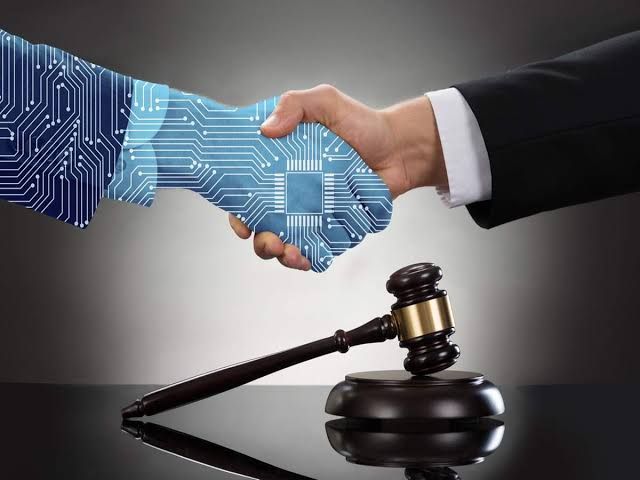Author: Radha Pachpor, a student at Dr. Ambedkar College, Deekshabhoomi, Nagpur.
Introduction:
In the contemporary digital age, technology has become deeply intertwined with the fabric of society, impacting every aspect of human life, including the legal landscape. This article explores the intricate relationship between technology and law, shedding light on the challenges and opportunities arising from this intersection. From privacy concerns in the era of big data to the complexities of regulating emerging technologies like Artificial Intelligence (AI) and block chain, the legal framework faces unprecedented challenges. However, amidst these challenges lie opportunities for innovation and the enhancement of legal systems to adapt to the evolving technological landscape. This article explores the multifaceted intersection of technology and law, examining key areas such as cyber security, data privacy, intellectual property, and the regulation of emerging technologies.
The Evolving Landscape of Data Privacy and Security:
One of the primary challenges posed by advancing technology is the protection of individual privacy and data security. From social media platforms to smart devices, vast amounts of personal data are collected, analyzed, and monetized by corporations and governments. The proliferation of digital devices and online platforms has led to the collection and storage of vast amounts of personal data, raising concerns about its misuse and unauthorized access. Legislation such as the General Data Protection Regulation (GDPR) in the European Union and the California Consumer Privacy Act (CCPA) in the United States attempt to address these concerns by imposing strict requirements on how organizations handle and protect personal data. The celebrated case of K.S. Puttaswamy V. Union of India (2018) pronounced the right to privacy a fundamental right safeguarded under Article 21. However, enforcing these regulations in a rapidly evolving technological environment remains a daunting task for lawmakers and regulators. As data privacy continues to be a focal point of public discourse, legal frameworks will play a crucial role in balancing innovation with the protection of individual rights.
Regulating Emerging Technologies:
As technology continues to advance at an unprecedented pace, policymakers are faced with the challenge of regulating emerging technologies in a manner that promotes innovation while mitigating potential risks. The rapid speed of technological innovation has outpaced the development of regulatory frameworks, leaving gaps in the legal landscape that can be exploited for nefarious purposes. Ethical considerations, safety concerns, and socio-economic implications must be weighed in the development of regulatory frameworks. Emerging technologies such as Artificial Intelligence (AI), block chain, and biotechnology present novel challenges for regulators, as their implications extend beyond traditional legal paradigms. For instance, the use of artificial intelligence in decision-making processes, such as hiring and lending, raises questions about algorithmic bias and accountability. Similarly, block chain technology, while offering unprecedented transparency and security, also poses challenges in terms of governance and legal enforcement. Balancing innovation and regulation is essential to harnessing the potential of these technologies while mitigating their risks.
Cyber security and Cyber Crime:
Cyber security stands at the forefront of the technology and law nexus, as the digital realm presents new vulnerabilities and threats. The interconnected nature of the digital world has also given rise to new forms of crime and security threats. Cyber attacks, data breaches, and online fraud have become prevalent concerns for individuals, businesses, and governments alike. The legal response to these threats involves not only punitive measures but also proactive strategies for prevention and mitigation. This includes investment in cyber security infrastructure, international cooperation in law enforcement, and public awareness campaigns to educate users about online risks. In Shankar vs. State, the Court observed that the charge sheet filed against the petitioner cannot be quashed with respect to the law concerning non-granting of sanction of prosecution under Section 72 of the IT Act. Moreover, legal frameworks need to adapt to the evolving nature of cyber threats, ensuring that they remain effective in combating new and emerging forms of digital crime.
Intellectual Property Rights in the Digital Age:
The digital revolution has transformed the way intellectual property is created, distributed, and consumed. With the proliferation of digital content and online platforms, issues such as copyright infringement, plagiarism, and digital piracy have become widespread concerns. In the case of Ferid Allani v. Union of India and Ors., the Delhi High court offered clarity for the words ‘per se’ by stating that “… sometimes the computer program may include certain other things, ancillary thereto or developed thereon. The legal framework governing intellectual property rights must strike a delicate balance between protecting the interests of creators and fostering innovation and creativity. This requires adapting existing laws to the realities of the digital age, as well as developing new mechanisms for enforcing intellectual property rights in the online environment. Moreover, international cooperation is essential to addressing intellectual property infringement across borders and ensuring that creators are adequately compensated for their work.
Conclusion:
The intersection of technology and law presents both challenges and opportunities for society. While technological advancements have transformed the way we live, work, and interact, they have also raised complex legal issues that require innovative solutions. By addressing concerns such as data privacy, regulating emerging technologies, combating cyber threats, and protecting intellectual property rights, the legal framework can adapt to the realities of the digital age. Moreover, collaboration between policymakers, technologists, and other stakeholders is essential to ensuring that the benefits of technology are realized while minimizing its risks. Ultimately, navigating the evolving landscape of technology and law requires a multifaceted approach that balances innovation with accountability, rights with responsibilities, and progress with protection. By navigating the digital frontier with foresight and diligence, we can harness the transformative power of technology to build a more just and equitable world.




